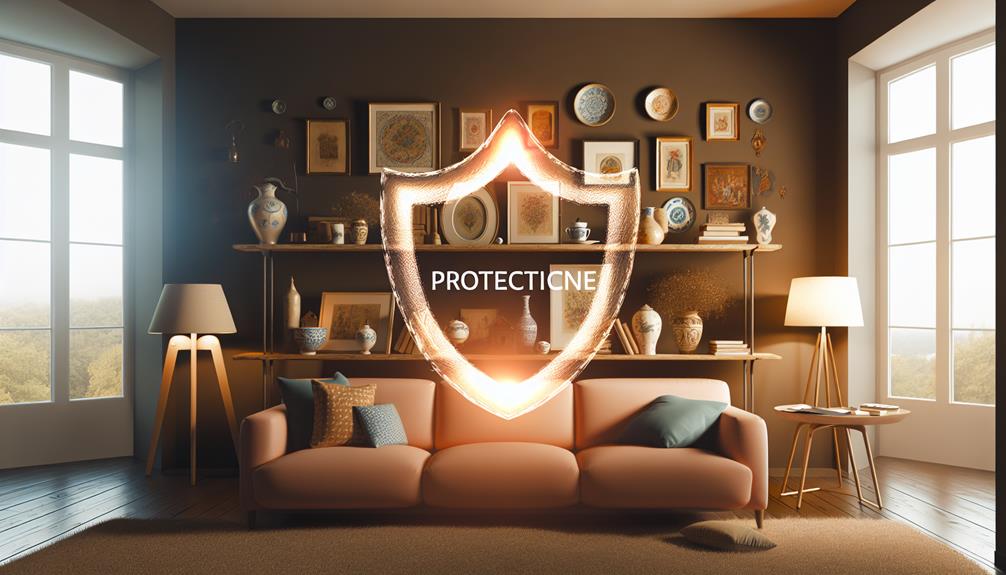Like a knight guarding a castle, your home insurance should protect more than just the walls around you. You might think your standard policy covers all personal property, but that's often not the case. Additional coverage options can safeguard valuable items that standard policies might leave exposed to risk. As you assess your needs, you'll want to contemplate what truly matters to you and how best to shield it. What specific items deserve that extra layer of protection, and how can you guarantee your policy reflects those priorities?
Key Takeaways
- Look for policies that offer scheduled personal property coverage for high-value items exceeding standard limits, like jewelry and art.
- Consider replacement cost coverage, which reimburses the full cost of replacing belongings rather than accounting for depreciation.
- Review endorsements available for additional coverage tailored to specific risks or high-value items to ensure adequate protection.
- Obtain multiple quotes to compare coverage options and limits, ensuring the policy aligns with your personal asset values.
- Regularly update your home inventory and inform your insurer of significant changes to maintain accurate coverage levels.
Understanding Personal Property Insurance
Understanding personal property insurance is essential for protecting your belongings inside your home. This type of insurance, often referred to as Coverage C in homeowners insurance policies, safeguards items like furniture, clothing, and electronics from loss, damage, theft, or vandalism. Typically, your personal property insurance coverage amounts to about 50% of your dwelling coverage. For example, if your home is insured for $250,000, you could have around $125,000 in personal property coverage.
When filing a claim, you'll encounter two primary settlement methods: Actual Cash Value (ACV), which deducts depreciation, and Replacement Cost Value (RCV), which reimburses you for the full replacement cost without considering depreciation. If you own high-value items like jewelry or collectibles, you might need scheduled personal property coverage, as standard policies often impose limits on these items.
It's also essential to maintain a home inventory to keep track of your belongings, ensuring you maximize your personal property limit. Remember that personal property insurance excludes certain risks, such as floods or earthquakes, which might require separate policies for thorough protection against specific covered perils.
Coverage Options Available
When it comes to home insurance, having a variety of coverage options can provide peace of mind and tailored protection for your specific needs. Most homeowners insurance policies include personal property coverage, which protects your belongings like furniture, clothing, and electronics from risks such as theft and fire. This coverage typically has limits of around 50% of your dwelling coverage.
You can choose between Actual Cash Value (ACV) or Replacement Cost Coverage (RCV). ACV accounts for depreciation, while RCV covers the full replacement cost of lost items. Many policies offer scheduled personal property coverage for high-value items like jewelry or art, ensuring adequate coverage limits.
Here's a quick overview of the coverage options available:
| Coverage Type | Description | Key Considerations |
|---|---|---|
| Personal Property Coverage | Protects belongings from specific perils | Usually 50% of dwelling limit |
| Scheduled Personal Property | Higher limits for high-value items | Requires separate listing |
| Off-Premises Coverage | Covers belongings outside the home | Often lower coverage limits |
| Optional Endorsements | Additional coverage for specific risks | Customizable per your needs |
Understanding these options can help you make informed decisions when filing an insurance claim.
Common Exclusions to Consider

While home insurance can offer valuable protection, it is vital to know the common exclusions that might leave you vulnerable. Many homeowners overlook these gaps in their personal property coverage, which can lead to unexpected expenses. Here are a few key exclusions to take into account:
- Flood and earthquake damage usually requires separate insurance policies.
- Maintenance issues, like wear and tear on personal belongings, aren't covered.
- Intentional damage to your property will not be compensated under your insurance policy.
Additionally, standard homeowners insurance often excludes business-related items unless you have a specific policy for that purpose. If you own high-value items like expensive jewelry or collectibles, you may need to secure additional coverage since they often have sub-limits under standard policies. Understanding these common exclusions is vital for protecting your personal belongings effectively. By recognizing what's not covered, you can take steps to fill those gaps and guarantee that your personal property remains safeguarded against potential risks.
Importance of Personal Property Coverage
Many homeowners underestimate the importance of personal property coverage until they face unexpected losses. This coverage is essential for financial protection, compensating you for the loss, damage, or theft of belongings like furniture, clothing, and electronics. Typically included in homeowners insurance, personal property coverage often equates to about 50% of your dwelling coverage amount, providing a significant buffer against unforeseen events.
When it comes to reimbursement, understanding the difference between Actual Cash Value (ACV) and Replacement Cost Value (RCV) is paramount. RCV offers better financial security, covering the full replacement costs without factoring in depreciation. If you own high-value items, consider scheduled personal property coverage to insure these assets for amounts beyond standard sub-limits, ensuring you're adequately compensated if they're lost or damaged.
Maintaining an updated home inventory is also key. It helps you accurately assess your personal property value, ensuring thorough coverage while aiding in claims processing. By keeping track of your possessions, you can identify significant assets that may need additional protection, giving you peace of mind in knowing you're prepared for any eventuality.
Evaluating Your Coverage Needs

To guarantee you're adequately protected, start by evaluating your coverage needs with a detailed inventory of your personal belongings. This inventory should include photos and estimated values to determine the total worth of items that require protection. Regularly reassess these values, especially after acquiring high-value items, to confirm your coverage limits are sufficient.
When considering personal property coverage, it's vital to understand the difference between Actual Cash Value (ACV) and Replacement Cost Value (RCV). RCV typically offers better financial protection by covering the full cost to replace items without factoring in depreciation.
To effectively evaluate your coverage needs, focus on these key aspects:
- Review your current homeowners policy for specific sub-limits, particularly for jewelry and electronics.
- Schedule high-value items separately to confirm they receive adequate protection beyond standard limits.
- Consult with insurance agents periodically to discuss potential adjustments based on current market values and changes in your personal assets.
Scheduled Personal Property Coverage
After evaluating your coverage needs, consider Scheduled Personal Property Coverage to protect your high-value items beyond the limits of a standard homeowners policy. This specialized coverage allows you to insure items like your engagement ring or valuable collectibles for an amount that exceeds the typical sub-limits found in homeowners insurance policies.
Standard policies often cap theft coverage for jewelry at around $1,500, which is insufficient if you own items valued considerably higher. Scheduled Personal Property Coverage not only raises your protection levels but also often lowers your deductibles for these high-value items, providing broader protection.
To secure this coverage, you'll need to provide proper documentation, including appraisals and clear photographs of each item, ensuring that their insured value is accurately represented. This is essential for protecting yourself against potential financial loss in the event of theft or damage.
If you own valuable collectibles or other high-value items, investing in Scheduled Personal Property Coverage can offer peace of mind and safeguard your assets effectively. Don't leave your precious belongings vulnerable—take the necessary steps to enhance your insurance coverage today.
Finding the Right Insurance Policy

Finding the right home insurance policy involves careful consideration of your unique needs and circumstances. Start by evaluating your personal property coverage. Typically, this covers belongings at 50% of your dwelling coverage amount, but it's essential to verify that's adequate for your situation.
To make an informed decision, keep these points in mind:
- Replacement cost coverage is preferable to actual cash value (ACV) since it reimburses the full cost to replace items without depreciation.
- Explore end endorsements for scheduled personal property, which can increase coverage limits for valuable items like jewelry or art.
- Regularly update your home inventory and inform your insurer about major changes to guarantee your coverage remains sufficient.
Don't forget to compare quotes from multiple insurance providers. Premiums and coverage limits for personal property can vary greatly, and you want to get the best deal to protect your belongings. By prioritizing these elements, you can choose an insurance policy that meets your needs and offers peace of mind.
Frequently Asked Questions
Does Homeowners Insurance Include Coverage and Personal Belongings?
Yes, homeowners insurance typically includes coverage for your personal belongings. This protection safeguards items like furniture, electronics, and clothing against loss or damage from covered events such as theft or fire. The amount of coverage is often around 50% of your dwelling's value. You can choose between Actual Cash Value or Replacement Cost Value for reimbursement. However, be aware that certain items may have coverage limits, so it's wise to review your policy.
What Is a Good Amount of Personal Property Coverage?
Think of your belongings as treasures in a chest; they deserve the right protection. A good amount of personal property coverage usually reflects the total value of what you own. Start by conducting a thorough inventory of your possessions. Generally, aim for coverage that matches or exceeds the value of your items, considering high-value items may need extra protection. Regularly review and update your coverage to guarantee it fits your current situation.
What Two Kinds of Insurance Can One Buy to Cover Personal Property?
You can choose between homeowners insurance and renters insurance to cover your personal property. Homeowners insurance typically protects belongings in your home and offers various coverage limits. If you rent, renters insurance is specifically designed for tenants, ensuring your possessions are covered against risks like theft or damage. Both options provide essential financial protection, so consider your living situation and the value of your belongings when deciding which insurance works best for you.
Which Homeowners Policy Would Be Written to Cover Personal Property Only?
Did you know that about 30% of renters don't have insurance for their personal property? If you're looking for a homeowners policy that covers personal property only, you won't find one. Homeowners insurance is designed to protect both your dwelling and personal belongings together. For standalone personal property coverage, consider renters insurance, which specifically protects your belongings without covering the home itself. This option might suit your needs better if you don't own a house.
